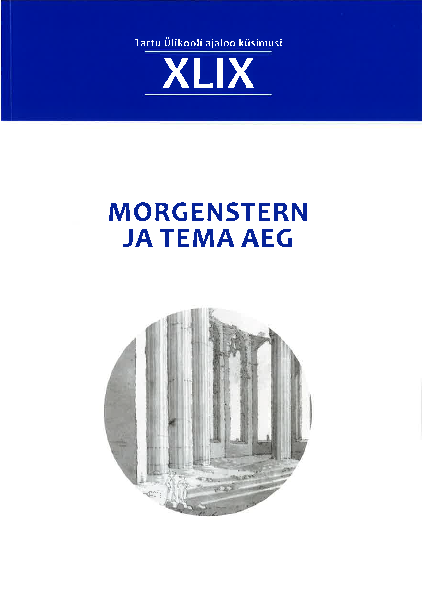Karl Morgensterni aegsete ülikooli kunstimuuseumi kogude saatusest 19. sajandi keskpaiga muudatustes
On the Fate of the Collections of the University of Tartu Art Museum from Professor Karl Morgesntern's Era at the Time of Changes in the Mid-19th Century
DOI:
https://doi.org/10.15157/tyak.vi49.18384Abstract
One of the central figures of the new permanent exhibition The University
of Our Lives at the University of Tartu Museum is the erstwhile
director of the library, Professor Karl Morgenstern (1770–1852).
Searching for museum pieces related to him brought up the question:
what has become of the art museum collections from Morgenstern’s
time?
The University of Tartu/Dorpat Art Museum was founded at the
university in 1803 as the first Estonian art museum. Its first director
was Karl Morgenstern, a young energetic scholar from Germany, who
held the position in 1803–1837. Founding the museum was supposed
to help achieve his goals as a professor, and aid students’ aesthetical
education. The museum supported practical art studies at the university
as well. The art museum of that time is primarily praised
for the diversity of its collections. By the end of Morgenstern’s term,
there were over 14,000 items in the museum: 2,684 prints, 707 books
/ albums of engravings, 94 drawings, 48 paintings, 5,067 gem casts,
5,348 coins and medals, 95 original antiquities from Egypt, Greece
etc., 63 ethnographic items and 22 plaster casts (sculptures).
Upon reading what has been written about the history of the museum,
and revising archive materials, it became apparent that a few
claims made about the development of the collections in the mid-19th
century must be clarified. While the fate of some collections (e.g., the
painting collection evacuated to Voronezh) is well known, there are
some collections the state of which the article will help to specify.
1. Mapping the collections has revealed that Morgenstern’s successors
in the position of the art museum’s director valued his collections
significantly less than what has been thought until now;
directors Ludwig Mercklin and Ludwig Schwabe removed many
plaster casts obtained during Morgenstern’s era from the collections, although this was the period when the museum focussed on
collecting more antique plaster casts. Hence, this shows the following
directors’ critical stand towards Morgenstern’s collections.
2. Although until now, ideological views related to the museum’s collection
policy have been emphasised as the reason for giving away
the art museum’s pieces, the motives could have been much more
practical: lack of space and several location changes in 1858 and
1868.
3. The often-cited committee decisions from 1858 and the following
processes do not have a linear cause-and-effect relation.
4. Finally, we are glad to announce that several formerly unknown
heritage pieces from Morgenstern’s era have been quite well
preserved outside the university, namely pieces from the ethnographic
collection, most of which were items brought in by Adam
Johann von Krusenstern from the Russian Empire’s first voyage
around the world (1803–1806). Many of those are now part of the
collection of the Estonian National Museum, where they significantly
supplement the rest of Krusenstern’s materials that we
know to have survived in Estonia.

